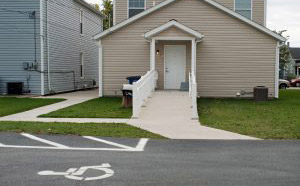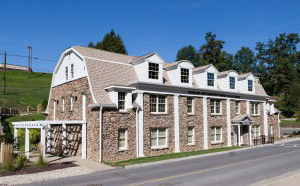A HOME’S EXTERIOR MATERIALS
November 26, 2019THE VALUE OF PURCHASING REPLACEMENT WINDOWS
November 28, 2019Most of us spend the majority of our time in our homes (and for those of us who spend the majority of our time at work, we wish we spent more time at home.) So, of course, we want it to be as comfortable as possible and affordable to maintain. Insulation is one of the most important components of a home that can help to affordably keep you and your family comfortable year-round. In the “Insulation and Air Quality” article, we talked about how insulation is like a home’s clothes. Just like you need to bundle up on a cold day, so your home needs to also be bundled up against the elements.
For example, if the air temperature outside the home is 95 degrees F, and you’ve cooled the inside air temperature to 72 degrees F, proper insulation will help to keep the hot air outside and the cool air inside. This keeps you comfortable and keeps the air conditioning bill to a minimum. While the concept may sound simple, a home’s insulation system is quite complex — entire books have been written about the subject. So, in this article we’ll give you the basic facts so that you can talk knowledgeably with your builder about how your new home will be insulated. And if you’re planning on remodeling the home and want to know more about insulation, this article will give you an overview to start you out.
How Heat Moves
The main function of insulation is to control heat flow. So in order to understand how insulation works, you need to first understand how heat moves.
In addition to heat from the sun and burning fuel, heat is also generated by people, animals and lights. In fact, as much as 30 percent of heat produced inside a home can be caused by lights and appliances.
The heat generated by all of these sources moves from place to place by three basic principles:
- Radiation
- Convection
- Conduction
For ease of understanding, we’ll discuss these concepts one at a time. In reality, however, radiation, convection and conduction typically are working simultaneously.
Radiation
One way heat can move is by radiation. “Radiate” literally means “to send out waves; to shine brightly.” When heat moves by radiation, it’s moving in the form of waves. Imagine you’re camping in the mountains. The evening air is cool, so you decide to build a campfire. As you stand in front of your campfire, your face and arms begin to warm. The heat you feel is moving by radiation from the flames to your body.
Convection
Another method of heat transfer is convection. Convection uses the principle that warm air rises and cool air falls to transfer heat via the flow of air. To continue with our camping scenario — imagine it’s dinner time. You begin to prepare dinner by placing a metal pan over the campfire grill. In a few moments, the metal pan is hot, even though it’s not directly touching the flames. How has this happened? Flames have heated the air, and the heated air has risen to heat the bottom of the pan. This heat transfer occurs via convection (with some help from radiation).
Conduction
A third method of heat transfer is conduction. Conduction is the method heat uses to move through a solid material. For heat to transfer from one surface to another by conduction, the surfaces must be in direct contact with each other. Back to our camping scenario — to cook your dinner, you throw a fish into the hot metal pan over the campfire. The heat transfers by conduction from the pan to the fish, cooking it.
How Heat Flow Affects Your Home
Heat transfers through walls, windows, and roof of a home using a combination of radiation, conduction, and convection. Heat moves from warm to cold. In the summer, when it’s warm outside, heat transfers through exterior walls, roof, and foundation of a home to the inside of the home. This process is referred to as heat gain. In the winter, the opposite will happen. Heat generated by the HVAC system moves through the building enclosure and is lost to the outside of the home. This process is referred to as heat loss.
In the summer, uncontrolled heat gain can cause you to be uncomfortably warm. Your thermostat will react to the warm temperatures, and the air conditioning system will have to run more often and for longer periods of time, resulting in higher utility costs. The same thing can happen in the winter, when uncontrolled heat loss can make your home drafty and chilly. To keep warm, you’ll need to turn up the thermostat, and the heating system will have to run more often and for longer periods of time, again resulting in higher utility costs.
How Insulation Works
A carefully considered insulation strategy that takes into account the house’s characteristics and the climate it’s in is essential for controlling heat gain and loss through the building enclosure, which includes the roof, walls, and foundation. It does this by slowing the rate of heat flow through the building enclosure — which has a significant influence on how comfortable you and your family are in the home.
Insulation is typically referred to by its R-value. R-value is the measure of a material’s resistance to heat flow. The higher the R-value, the more resistant a material is to heat flow. If you lived in Minnesota, for example, you’d want R-19 insulation in the walls instead of R-13, because R-19 insulation is more resistant to heat flow, and will hold in the heat longer. If you’re remodeling the home, you’ll want to find out the ideal levels for your region. A good resource is the Department of Energy (DOE).
The building enclosure should be insulated continuously without gaps. Having gaps in the building enclosure is similar to wearing a warm coat, but no gloves or hat. But keeping the insulation continuous is tricky. There are numerous openings in the building enclosure, like for windows, doors, electrical outlets, plumbing pipes, and lighting fixtures. All gaps or openings need to be sealed so that the insulation is continuous.
Choosing an insulation material and installing it right are critical steps in the insulation strategy. Now that you know the basics about how insulation works, and why it’s critical in your home, start talking with your builder about the insulation strategy they’re choosing for your home, and why. You should do this in the planning and design phases of your home.
Staff Writer (2013 December) Insulation Basics. Retrieved on December 27, 2013 From DIY.com
To make sure your home is properly insulated contact Tri-County Exteriors


